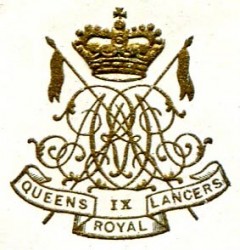This cavalry regiment was originally formed in 1715 in Bedford in response to the Jacobite Rebellion. Originally known as Wynne’s Dragoons after Major-General Owen Wynne (1665-1737) who had raised the Regiment, it was renamed 9th Light Dragoons in 1783. At the same time, their scarlet uniform was changed to blue. The Regiment served in the Irish Rebellion of 1798 and participated in Wellington’s Peninsular War between 1811 and 1813. In 1816, the 9th Light Dragoons were constituted Lancers, and in 1830 they were given the courtesy title ‘Queen’s Royal’ after Queen Adelaide, consort of King William IV. The Regiment became best known for its involvement in the Indian Mutiny of 1857, during which its cavalrymen earned the nickname ‘the Delhi Spearmen’.
On the outbreak of the First World War, the 9th (Queen’s Royal) Lancers formed part of the second Cavalry Brigade of the first Cavalry Division of the British Expeditionary Force. On 7 September 1914, they participated in the First World War’s last ‘lance on lance’ battle between two lancer units. The Regiment only operated as a cavalry unit in 1914, as the widespread use of machine guns and shelling made cavalry regiments unworkable. For the rest of the war, the Regiment operated as infantry in the trenches. The 9th Lancers are among the most decorated of the British cavalry regiments, having been awarded 15 Victoria Crosses, 12 of which were awarded during the Indian Mutiny.
The only 9th Lancer to receive the Victoria Cross during the First World War was Captain Francis Grenfell (1880-1915) who, on 24 August, although severely wounded, helped manhandle and push into safety the guns of the 119th battery of the Royal Field Artillery under a hail of bullets. As he was recovering from his wounds in hospital, news of the death of his twin brother, Riversdale ‘Rivy’ Grenfell of the 9th (Queen’s Royal) Lancers, was broken to him.

